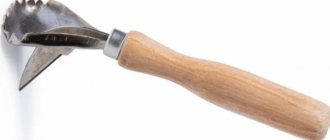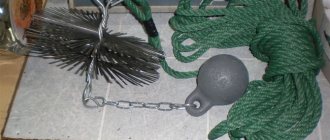“He who has not eaten potatoes knows no pleasure!” - we sang as children. And so it is. Many people like to eat potatoes every day. Of course, because you can prepare a lot of dishes from it, so we will never get tired of it. But in order to cook it, you need to thoroughly clean it. And here we are faced with a dilemma - which knife to choose for this, because now the industry offers such a large assortment. But this depends on the dish you plan to prepare.
A potato peeler makes preparing dinner much easier.
Choosing a knife for peeling potatoes
Before you start cleaning, decide on the type of knife.
If it is chosen incorrectly, the result can be unpredictable. Recommendations for selection:
- Do not use large knives or cleavers. The blade should be short and the knife itself should be small. A special vegetable knife is perfect.
- The handle should be comfortable and fit well in the palm of your hand. It’s good if it’s rubberized, so the knife won’t slip in your hand.
- The blade must be sharp. It will glide smoothly across the surface and cut the peel more thinly. In addition, a dull knife can cut you faster.
Peeler Tefal
The classic vegetable peeler from Tefal from the Comfort series is equipped with 2 vertical blades. This makes it convenient for both left-handers and right-handers. The rotary blades are made of high-quality steel that does not darken over time and does not rust. At the tip of the vegetable peeler there is a special knife for removing eyes from potatoes. There is a hole in the handle so you can hang the tool on a hook.
Advantages:
- Sharp blade. — Cuts off a thin layer of peel. — Stainless steel blade.
Flaws:
— Not a very comfortable handle. — The eye-removal knife is not made of plastic.
How to properly peel young potatoes
Despite the fact that young potatoes can simply be peeled with a regular knife, the procedure should be carried out in compliance with certain rules. In addition, there are several other ways to remove the peel from the surface.
Traditional cleaning method
Usually, young potatoes are not peeled, but simply scraped off the skin. For the procedure you will need a small vegetable knife and running water.
Action plan:
- Remove sand and dirt from the surface of the root crops.
- Lightly scrape the skin off the surface.
- Rinse each potato under the tap to remove excess skin.
- Cut off eyes and dark spots.
Peel new potatoes with salt
Try removing the skin from the surface of the potato using regular salt. For the procedure, you will also need a container with a lid or a tight bag.
Procedure:
- Place vegetables in a bag or container.
- Add rock salt to potatoes.
- Shake the pan or bag thoroughly several times.
- Remove any remaining skin by rinsing the potatoes under running water.
Pay utmost attention to the choice of container for cleaning: if it is a bag, it must be strong enough not to tear from mechanical stress, and if it is a pan, the lid must close tightly.
How to clean with a sponge
You can quickly peel young potatoes using a metal dish sponge. For safety reasons, use only new, rust-free sponge.
Cleaning process:
- Wash the potatoes.
- Rub the surface of each potato with a metal sponge.
- Remove the eyes with a knife.
- At the last stage, wash the already peeled potatoes again to remove excess peel.
Clean with a sieve
The method is suitable for peeling small young potatoes, as a result of which the root vegetables will remain without peeling and their integrity will be preserved.
Description of the method:
- Select a small sieve with small cells.
- Pour the potatoes into a sieve and place in the sink.
- Turn on the water.
- Roll the vegetables on the grid under running water several times.
- Remove any remaining eyes.
- Before cooking, thoroughly wash the already peeled potatoes.
Peeling boiled potatoes
Potatoes, boiled with their skins, differ in their taste and are used to prepare many dishes.
There are two ways to clean such tubers.
Method 1:
This is one of the most common peeling methods, in which you need to remove the potato from the water, place it on a board or plate, prick it with a fork and remove the skin with a knife.
This is a good way to peel very hot tubers while saving as much edible pulp as possible.
Method 2:
The following method will help you get rid of the skins on tubers in almost a couple of seconds:
Wash the potatoes well, then make circular cuts, running the knife along the so-called equator
It is very important that the starting and ending points of the cuts coincide. After this, send the tubers to the stove to cook
Before finishing the cooking process, prepare a pan with very cold water.
You can even throw some ice in it for a better effect. Now, using a slotted spoon, transfer the potatoes to a pan with ice and count to about ten.
Next, remove the tuber from the water and press it with both hands from different ends.
Thanks to this method, the peel peels off quite easily and quickly.
At the same time, the potatoes themselves will remain quite hot. This way, you can peel the potatoes in a minimum amount of time without burning your hands.
Important:
You need to learn how to peel young potatoes correctly.
If you approach this process ineptly, then your hands, and maybe even other parts of your body, will have the color of iodine. When cleaning young tubers, it is recommended to wear rubber gloves.
Following these simple rules, time-tested in practice
, any housewife can easily, safely and quickly peel any number of useful tubers. In order to get the result you want, simply choose the option that is suitable for you. And the variety of different recipes will allow you to add spice and also please your loved ones.
How to quickly peel raw potatoes?
To quickly peel potatoes, you need to use one of the simple methods. All of them do not require any special equipment and allow you to quickly cope with unpleasant work.
Clean with a vegetable knife
The easiest way to peel potatoes is if you do it with a small knife. It must be well sharpened and have a comfortable handle that will not slip in your hand.
Correct sequence of actions:
- Thoroughly washed tubers are placed on napkins and quickly get rid of excess moisture. This simple operation will help remove all dirt from the vegetables and prevent them from slipping while peeling.
- The knife is directed away from you and is used to cut off the inedible layer. This is best done in a spiral.
- After this, the tubers are washed with cold water.
- At the very end, various defects (eyes, blackened areas, damage) are removed.
Using a vegetable peeler
Peeling potatoes with this tool turns from a boring task into an interesting and safe activity. You can buy a vegetable peeler at any store that sells kitchen utensils and household goods. Its cost varies depending on the quality of the material and the manufacturer.
Step-by-step instruction:
- The potatoes, previously washed from dirt, are placed on a tray or wooden board.
- After 15 minutes, moisture will evaporate from its surface, which will interfere with work.
- The device is taken in one hand and the potatoes in the other.
- After this, they begin to carefully peel off a thin layer of peel along the entire vegetable.
- The peeled potatoes are washed again and cut into the required pieces.
A quick way to clean with a drill
To peel potatoes with a drill, you must thoroughly wipe the tool you are using. The best option would be to use a newly purchased device that has not been used for its intended purpose.
To carry out the work, you must perform the following steps:
- Purchased or collected tubers are placed in a bucket.
- They are filled with cold water and left for 5 minutes.
- During this time, prepare the drill by attaching a clean brush or any similar product to its rotating element.
- The device is connected to a power source, and the installed nozzle is lowered into a bucket.
- Using a working drill, perform circular movements, trying to get to each tuber.
- After this, the water is drained, removing the separated skin.
How to peel potatoes in a few seconds?
You can peel raw potatoes with a knife in a few tens of seconds. To speed up this procedure several times, you need to use a special method. It is as follows:
- Potatoes, cleaned of dirt and plant debris, are kept at room temperature for 20 minutes.
- After this, take a knife and run it around the entire circumference of the tuber. It is important that the cut is not too deep and also ends at the same point where it began.
- In this form, the root vegetable is placed in hot water.
- After a few minutes, it is removed from the boiling water and placed in the ice-cold liquid.
- After all these manipulations, take the potato with both hands and perform a stretching movement.
- If everything is done correctly, the peel will come off without much effort.
Quick peeling of boiled potatoes
Ready-to-eat potatoes must be peeled so that they do not fall apart into small pieces. To do this you need to do a few simple steps. Among them are the following:
- Pour cold water into a bowl and put a few pieces of ice in it.
- The potatoes, boiled in their jackets, are removed from the boiling water and immediately placed in ice water.
- After 30 seconds, the tubers are removed and a transverse cut is made on the skin.
- Then, with a light movement, remove the peel, starting to separate it from the edible part at the cut site.
- Do the same with all other vegetables.
Recommendations for care and storage
If you lack the necessary skill, a potato peeler can easily break. If handled with care, the instrument will last for many years. It is advisable to wash steel with not very hot water so that the blades do not become dull. Ceramics are fragile; impacts cause the cutting blade to chip. It is better to store it away from other tableware.
An inexpensive potato peeler can be easily replaced after it becomes dull and becomes difficult to peel. Expensive tools are handed over for sharpening in special workshops, where editing is done on machines.
Blades should be kept dry and clean after each use. Wipe them with care so as not to cut your fingers. It is better to remove excess moisture with a paper towel.
It is advisable to wash steel with not very hot water so that the blades do not become dull.
When choosing a tool for peeling potatoes, be sure to take into account the location of the blades. Horizontal ones are universal; they are used for other vegetables. Pillers with vertical cutting blades are more convenient for large potatoes. Tools with fixed blades are more difficult to handle. Ceramic peelings do not oxidize and cause young potatoes to darken less. For left-handed people, experts recommend purchasing knives with double-sided sharpening. Bright plastic handles are advantageous - they are immediately noticeable and easy to find. They grip comfortably and do not slip in the palm.
When choosing a tool for peeling potatoes, be sure to take into account the location of the blades.
When choosing a tool for peeling potatoes and preparing original-shaped fries, it is better to give preference to proven brands. They use high-quality certified steel and environmentally friendly plastic. Each housewife chooses the shape individually so that it is convenient to use the kitchen tool.
How to peel potatoes boiled in their jackets?
A root vegetable cooked in its jacket is much easier to peel than a raw one. Despite this, there are several effective methods that can be used to help make the process even easier.
TRAMONTINA UTILITA
A simple potato peeler from a Brazilian manufacturer. The device is created in bright attractive colors. It copes perfectly with all the tasks, removes skins well from vegetables and fruits, not just potatoes. The knife is stainless steel, hardened in several ways for extra strength. Copes with the processing of soft fruits, the juice does not disappear from them.
| A country | Brazil |
| Knife material | Stainless steel |
| Color | Blue |
Price: about 150 rubles.
pros
- gently removes skins from vegetables and fruits;
- high-strength materials and stainless steel;
- resistance to external influences and high temperatures;
- the knife is securely attached to the handle.
Minuses
- not found.
Peeling potatoes is much easier with a special knife. It is well sharpened and fits comfortably in the hand due to the high-quality handle. I save time and my own energy, cooking brings pleasure at all stages. An excellent option that combines high quality and low price.
WEBBER BE-5288
This multi-functional, attractive potato peeler boasts high-quality, sharp, floating-type blades. Allows you not only to peel vegetables and fruits, but also to carefully cut hard vegetables into strips and decorate dishes with them. The blades are mounted on a special drum, you are reliably protected from cuts, damage, and injury. The handle has several rubber inserts that prevent it from falling.
| Colors | Green, orange, red |
| A country | Germany |
| Material | Stainless steel |
Price: from 99 to 149 rubles.
pros
- floating blade makes cleaning easy;
- cutting potatoes into strips;
- the blades are fixed to the drum, the user is protected from damage;
- comfortable rubber handle.
Minuses
- not found.
A simple potato peeler captured my attention. Inexpensive, lightweight, effective. Does an excellent job of cleaning and chopping vegetables. The knife is firmly connected to the main part of the structure, does not slip and is securely fastened. Most often I peel carrots and potatoes with a knife. During the period of operation (almost six months), the device never failed. I recommend to everyone the ideal potato peeler in terms of price-quality ratio.
AOT VERSION P03
The device effectively cleanses vegetables and fruits, preventing loss of juice and nutrients. The design is based on plastic of high strength and quality. It is easy to clean and long-term use, does not break or crack due to large volumes of work. There is no need to use special products for maintenance - just wipe the device with a soft cloth. The device comes with 2 nozzles and a main cleaning blade.
| Color | White |
| Production | China |
| Material | Plastic |
Price: from 1199 to 1999 rubles.
pros
- the body is made of high quality plastic;
- not demanding in care;
- the presence of a special anti-slip coating.
Minuses
- Not sold in all stores.
We use an electric vegetable peeler in a cafe, saving a lot of time and effort. We quickly process a large amount of raw materials, we are pleased with the high strength of the materials and the high quality of work. We all like the device, we recommend purchasing it for your home or cafe.
FIRST AUSTRIA FA-5120 WHITE
A miniature and extremely ergonomic device, marketed by an Austrian manufacturer. The design is universal and fits into any kitchen interior. The cleaner is made in a round shape, the drum has a large volume. In addition to its main function, the potato peeler is also excellent at cutting vegetables and fruits, especially as decoration. There is a transparent lid on top of the body, through which you can control the process of peeling vegetables and fruits and stop it in time.
| Manufacturer | Austria |
| Knife material | Stainless steel |
| Colors | White |
Price: from 1199 to 1999 rubles.
pros
- the drum holds up to 1 kg of vegetables and fruits;
- knows how to cut food, preserving its nutrients;
- The transparent lid allows you to observe the cleaning process;
- special compartment - the power cable is stored in it.
Minuses
- not detected.
Awesome cleaner! With its help, I save a lot of time and create vegetable and fruit slices that look simply delicious. Separately, I would like to note the large capacity of the case and the transparent lid - through it it is convenient to observe the process of cleaning the products. The knife is sharp, does not require self-sharpening, and the entire design is safe and high quality.
Curved knife
A distinctive feature of this type of tool is its shortened but curved blade. Thanks to this, potato peeling takes place quickly, without significant waste. The tool fits well in the hand, providing maximum comfort when it comes to long-term peeling of vegetables. The knife blade is wide, allowing you to peel potatoes in a few hand movements. The pointed end helps remove eyes and other shoots of the tuber. However, there is a significant drawback - you need to handle the tool carefully to protect yourself from accidental wounds.
Floating blade knife
After their appearance on the market, knives with a floating blade became the most popular, as this part ensures safe peeling of any vegetable, regardless of shape. Almost every model uses a blade with a 360-degree rotation angle, significantly speeding up the process of peeling vegetables and fruits. Knives of this type have two types of blades: with and without serrations. The second type of knives presented is more convenient for peeling potatoes.
How to store peeled potatoes
Storing peeled potatoes is difficult. The root crop becomes covered with black spots in a short time. There are several methods recommended for long-term storage.
- A common method is to store the root vegetable in cold water. However, do not forget that storing it in this form will lead to the dissolution of vitamins and nutrients in the composition. To slow down this process, store potatoes as whole tubers.
- It is worth noting that the shelf life of potatoes without loss of nutrients is no more than 3–4 hours. Premature blackening of fruits occurs due to the active use of nitrogen during cultivation. To slow down the process, add a slice of lemon to the pan along with the potatoes.
- For longer storage, it is recommended to use the cold water soaking method in the refrigerator. After peeling the potatoes, place them in cold water. Soaking in ice water slows down the blackening process of the product.
- Before you start cooking, rinse the root vegetable again with water. However, this technique is not suitable when it comes to preparing boiled potatoes, since long-term storage in water reduces the density of the vegetable crop.
- To maintain the density of the tubers, you need to place the peeled potatoes in a bag and put them in the freezer. The bag must be tied to prevent air from entering. Otherwise, the method will not have the expected success. There is no need to defrost potatoes before cooking; you can immediately plunge the root vegetable into salted, boiling water.
- To preserve sliced potatoes for a long time, you will need cling film. First, wash the peeled tubers, removing any starch that is released. Dry the washed root vegetable with a towel, then proceed to cutting the potatoes. After this, wrap the chopped root vegetable in cling film and place it in the freezer. Cut potatoes can only be stored in the freezer.
There is no need to defrost the vegetable before cooking. If you want to cook fried potatoes, place the slices in a heated frying pan, after greasing them with sunflower oil. If the cut potatoes are intended to be boiled, then place them in boiling salted water.
«Important:
All information on the site is provided for informational purposes only. Before applying any recommendations, consult with a specialized specialist. Neither the editors nor the authors are responsible for any possible harm caused by the materials.”
Universal paring knife: how to use?
Nowadays, not only the taste of the prepared dish is valued, but also the aesthetic design. Decorations made from figuratively cut products are popular. Manufacturers are constantly improving their quality, design, and functions.
A vegetable knife or vegetable peeler is a difficult to replace assistant in the kitchen. It can be used to peel carrots, potatoes, and other vegetables and fruits very quickly and without much effort. By slightly adapting to its use, you can get rid of a lot of work in a few minutes. Such knives are called peelers; they can be manual or automatic.
Vegetable peelers are similar in appearance to a razor with two blades facing each other. Their functions are superior to ordinary kitchen knives. They are specially designed for fast, high-quality and safe work with products. They can be trusted for use by children, since the peelers cannot scratch or cause any injury.
Pillers are manufactured with fixed and movable blades. Both models are popular, although some believe that the fixed blade removes excess layers of the vegetable along with the peel.
The floating blade is designed for bends and uneven surfaces of products, does not pierce or violate the integrity of juicy vegetables and fruits. When choosing, experts advise paying attention to models with a ceramic blade. Unlike metal ones, which also have their undeniable advantages, ceramic products are not subject to corrosion, do not react with the products being cleaned, and have a self-sharpening edge. Vegetable peelers are equipped with a metal or plastic handle. The models are made in various, often bright colors, which do not allow them to get lost among other kitchen utensils.
Some models are equipped with pointed tips, which are very convenient for removing damaged areas and potato eyes. It can also be used for cutting products into thin layers or long ribbons for original decoration. The only thing that vegetable peelers cannot handle is the thick peel of lemons and oranges; for them you will have to use regular kitchen blades.
Types of knives for peeling potatoes
Piller knives
Peelers can only be used for peeling or if you need very thin slices.
Such a knife is practically safe, since it is difficult to cut yourself with it, and if you do, the wound will be superficial. It will take some time and skill to appreciate their convenience. According to their design, there are two types of pillers: with a handle in the form of a slingshot or in the form of a regular knife, but with a longer handle. The slingshot peeler knife is similar to a razor with a rounded blade. Which knife shape to choose is a matter of personal convenience.
This type of knife allows you to minimize waste, which is especially important when peeling potatoes from a fresh harvest. Piller knives allow anyone to preserve the useful weight of the fetus as much as possible, which previously only an experienced housewife could do with a regular knife
Potatoes are peeled using two blades directed towards each other with a small gap. Thus, the knife is suitable for both right and left hands, while becoming safer. These models were the most comfortable before the introduction of the floating blade model.
Floating blade knife
Knives with a floating blade, already similar to a razor, continue to repeat its design features. The floating blade can be rotated in any direction, allowing you to follow any shape of the fruit and clean as efficiently as possible. This particular knife can make peeling potatoes an inconspicuously quick job.
What kind of knife is convenient for cutting vegetables and fruits?
A kitchen knife for vegetables and fruits does an excellent job of not only peeling or removing the core. It is successfully used for slices of any hardness, as well as for decorative purposes. Ideal for hard to reach areas on any product.
Models of this type are made with a small blade from 7.5 cm to 10 cm in length. It has a pointed tip, which is convenient for removing various flaws, eyes, making decorations, checking vegetables by piercing them during cooking. A small knife for slicing vegetables with a well-balanced blade, comfortable to hold in your hand. It is easy to use and is one of the most affordable and favorite tools for working in the kitchen.
A universal knife - similar in appearance to a vegetable cutter with a longer blade, whose size ranges from 11.5 to 20 cm. The shapes differ not only in length, but can also be different in width, in the blade - straight or wavy, sharp or blunt tip. Some knife models have small serrations on the cutting edge. They are especially convenient for cutting delicate foods, such as overripe juicy fruits or soft tomatoes, which with other types of knives get crushed and lose their juice. They can equally easily peel the hard peel of beets, the thick shell of citrus fruits, cut into slices, strips, chop and dice any type of product.
Small curved knife
A sharp small knife with a curved blade, the tip of which is lowered. This specific shape makes it convenient for cleaning round tubers. Typically, such knives are no longer than 8 centimeters; there is no need for a larger potato knife. The curved blade cuts the peel well, and the sharp tip cuts out the eyes.
What materials should I choose for cleaning knives?
The blades of cleaning knives can be stamped from stainless steel, zinc (such knives are double-edged), ceramics (brittle but very sharp blades that do not stick to the product). Ceramic knives are still quite expensive. They justify the price by the fact that they do not oxidize food, do not absorb odors, and are excellent at cutting complex foods like tomatoes, even soft ones with thick skin, but they disappoint with their fragility. Once you break off a piece of the blade when trying to cut a product that is too hard or frozen, such a knife can no longer be repaired.
Such knives cannot be sharpened, so if the knife is sharpened only on one side, it will be inconvenient for left-handed people to use. The handle can be made of either plastic or metal. Plastic is warmer and more comfortable in the hand, a knife with a metal handle is more durable.
Advice!
Vegetable peeling knives are divided into potato peelers and universal knives for peeling vegetables and fruits. Universal knives are suitable for fruits of any shape and size; potato peeling knives are highly specialized for peeling these particular tubers.
The first devices for quickly peeling vegetables appeared in France in 1929. Due to their simplicity and convenience, they quickly conquered the market. Now you can buy them at any hardware store, hypermarket or IKEA store.
The industry also has its own methods of peeling potatoes from unnecessary peels, and they are very different from household ones.
Industrial peelers of vegetables consist of a tank for filling potatoes, where the walls are covered with coarse emery stone. During this cleaning, the peel turns into mush. Sometimes, to make peeling easier, the fruits are treated with steam. As you can see, although this cleaning method is automated, it is poorly applicable at home.
Peeling raw potatoes
You can peel raw root vegetables using a paring knife or a special vegetable peeler. Peeling is not convenient for everyone, especially if there are a lot of holes in the potatoes, you will still have to use a knife. But the big advantage of this tool is that there is very little waste when peeling, because the peel is cut very thin, which cannot be done with a knife.
Cleaning with a knife
Many people have known since childhood how to properly peel potatoes with a knife. But for those who are not familiar with this activity, you need to follow these steps:
- The fruits need to be washed from dirt and soil.
- Use a vegetable knife to cut the peel in a circle.
- Rinse the root vegetables.
- Cut out eyes and damaged areas.
Peeling
A special vegetable peeler cleans the peel more quickly.
It is best to use metal or ceramic vegetable peelers. Root vegetables need to be washed, peeled, cut off the eyes with a knife or a special tip and rinsed under running water.
You can peel the tubers without washing them, but then the root vegetables will need to be washed more thoroughly after cleaning.
https://youtube.com/watch?v=RzUHF1fPZ1c
Knives for cutting potatoes and vegetables
Carving - the artistic cutting of vegetables, giving them an unusual beautiful shape, creating entire compositions and paintings from simple ingredients has been very popular lately. To successfully work in this direction, you need a high-quality tool, and more than one.
To perform all carving techniques you need to have the following set of knives:
- A spiral slicer turns an ordinary cucumber or carrot into a colorful garland.
- A specialized knife for creating petals of a specific flower, star, or geometric shapes. Time is very valuable in carving, as vegetables quickly wither and lose their appearance. Therefore, having a tool that allows you to quickly implement this or that design is simply necessary.
- A knife for cutting out perfect circles and a slicer for shredding may be needed to make homemade potato chips.
- Knives for creating a wavy edge are useful in many recipes: beautifully shaped potatoes can make even an ordinary dish festive.
Stainless steel.
Stainless steel knives are made from steels with high corrosion resistance. To prevent a chemical reaction from occurring at the moment of contact with food, an almost transparent oxide film is applied to the steel.
The tool perfectly grips the peel and removes it in a thin layer.
Many knives are made from steel. Not all of them are considered ideal from the point of view of consumer properties. Only four meet all the requirements.
- 12C27 (Sandvik);
- AEB-L (Uddeholm);
- DD400 (Minebea);
- AUS
If we ask professionals what kind of steel they consider the best, the answer will be: “There is no better than Damascus and damask steel!” Previously, in order to note the excellent qualities of the blade, it was reported that it was made of Damascus steel. The quality of damask knives depended on the professional qualities of the blacksmith, the quality of heat treatment and grinding. If we compare a Damascus blade with a damask blade, then the first is superior to the second in strength. When the question arises about cutting properties, the qualities here are equal.
This potato knife is comfortable to hold in your hand and the handle does not rub.
Ceramics
Ceramic knives are special. In their manufacture, one specific technical process and a single material are used. Since zirconium oxide is used in the process, they can be either black or white. They are hard and heat resistant. Zirconium oxide absolutely does not react chemically with many active substances - acids and alkalis.
Ceramics is an environmentally friendly modern sintered composition used for the manufacture of kitchen tools.
Their virtues.
- Hardness. Due to the strength of the blade, it is not afraid of scratches, so the attractive consumer appearance remains for a long time.
- They are not subject to rust and are easy to clean.
- The blade is very smooth.
- Ecological cleanliness. There is no unpleasant aftertaste after cutting.
The components of ceramics are inert, they do not destroy vitamins and do not absorb aromas.
Note! They can last for a long time without sharpening!
Flaws.
- Sharpening is done only with special sharpeners.
- They don't like impacts, so washing them in the dishwasher must be done carefully.
- Note! They can only be cut on special cutting boards - wooden or plastic.
Tupperware peeler
Vertical vegetable peeler from Tupperware. The blade removes a layer of peel no more than 2 mm thick. It is fixed in such a way that it is convenient for them to peel vegetables of any shape, especially round ones. After use, the blade must be washed and dried to prevent rust. At the end of the vegetable peeler there is a device for removing eyes from potatoes and carrots. The tool is suitable for cutting vegetables. The handle is made of plastic with a non-slip coating.
Advantages:
— Ergonomic handle. - Sharp blade. — High-quality steel.
Flaws:
— Cannot be washed in the dishwasher. — The blade is not secured securely enough.
Japanese knives
The gyuto is made from the densest possible steel.
The only negative is increased fragility, so they can only be used for cutting.
Gyuto is the equivalent of a European chef.
Note! No sharpening required!
The Japanese santoku knife has not taken root very well among us. Yes, this twenty-centimeter and very convenient wide knife is not used by our chefs. But the Americans have long had their eye on it and switched to this model.
Santoku is a type of universal chef's knife.
The blade is 16-20 cm long and 4-5 cm wide. The triangular shape of the blade makes it possible to use the edge 100%. To reduce food sticking to metal, there are special grooves on the knife blade. Thanks to the sharpening angle from 6 to 10 degrees, it perfectly copes with its functions.
Application area:
- cutting and slicing meat;
- chopping fruits and vegetables;
- cutting fresh herbs;
- seafood cutting.
It was originally invented for cutting beef, and then began to be used for most basic cooking operations.
Note! It can cut even the softest bread!
Material: High carbon steel, high temperature hardened.
Note! Some models are made of stainless steel.
Nakiri is a knife for vegetables and herbs with a thin and light blade. They are very convenient for cutting and shredding. Length – 16–18 cm, width 5–6 cm. Made of stainless steel, which is resistant to corrosion.
The Nakiri is a medium-sized utility knife designed for working on a cutting board.
The splitting knife is a new and original model. You need to work with it with both hands. Consists of a semicircular blade and two handles at the top. Although it was originally intended only for quickly shredding meat, it can also be used for vegetables. You just have to get used to it!
With a wide symmetrical semicircular blade and two handles on the edges for chopping greens, it is most often used in a professional kitchen.
Knife for vegetables and fruits. All knives can cope with chopping large vegetables. And if minor work is required, then problems begin. Dimensions are a disadvantage here. That's why these knives are so popular. Their blade is 7-12 cm. The blade is straight or concave. It's easy for them to work.
The vegetable and fruit knife differs from the standard model in that it has a small blade.
Manufacturing materials
In order for the knife to serve for a long time, you should pay special attention to what this piece of kitchen utensil is made of. The main attention is paid to the blade, but do not forget about the material used for the handle
It is worth giving your preference to the non-slip version, it will be convenient for long-term use.
Recently, manufacturers have also begun to achieve an ergonomic shape that fits perfectly in the hand and minimizes friction during operation. Wood, metal or non-slip plastic can be used for the handle, while the main competition for blade materials is ceramic and stainless steel.
ADVICE:
Stainless steel
One of the most widely used materials from which most kitchen appliances are made. This is due to a number of advantages of this type of steel: a stainless steel knife will not oxidize and will not impart a characteristic metallic taste to your products; it can withstand temperature changes well without changing its functionality. The material is impact-resistant and reliable to use.
Ceramics
Recently, kitchen utensils made from this material have been gaining popularity. Ceramic knives have excellent sharpening and are quite sharp, and most importantly, they retain this quality for a long time, they do not absorb unpleasant odors and are easy to clean. The main disadvantage is the inflated cost of the relatively high fragility of this material; for the most part, ceramic knives do not withstand falls or strong impacts.











